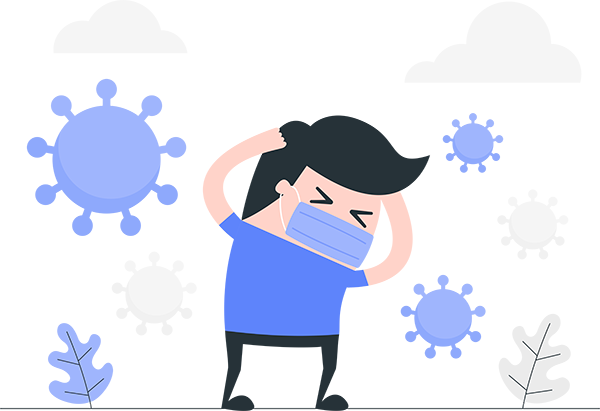COVID-19 and Anxiety
by Robin Cooper, MD
May 22, 2020
 Around the world, we have an understandable and pervasive feeling of anxiety and an April poll found nearly half of Americans said the pandemic has affected their mental health. With much of the world’s population being instructed to avoid other people physically and to stay home because of a virus that could kill millions, that anxiety is not just understandable—it’s a natural and appropriate response.
Around the world, we have an understandable and pervasive feeling of anxiety and an April poll found nearly half of Americans said the pandemic has affected their mental health. With much of the world’s population being instructed to avoid other people physically and to stay home because of a virus that could kill millions, that anxiety is not just understandable—it’s a natural and appropriate response.
I understand this both as a psychiatrist and as a 70-year-old living in San Francisco. I’m fortunate that I can continue to work from my home but worry for my physician and nurse adult children who work caring for patients.
In speaking with people about our collective emotional state, I offer this message: anxiety isn’t necessarily bad. It’s hard-wired into us and why our species survives to this day. Without it, our ancestors would have sat staring blankly when we encountered a lion in the bush. Our challenge is to manage it; to make this feeling that can overwhelm work for us.
When we manage our anxiety, we can respond appropriately to what sits in front of us.
Responding to COVID-19, the appropriate response is to stay physically apart to “flatten the curve” without locking ourselves inside our bedrooms watching cable news obsessively.
Managing anxiety sounds easy when I write it, but it’s not. Like millions of people across the country, I have anxiety about climate change that can wake me in the night with fears about my failure to protect my children and grandson. I now use the same strategies to harness and redirect anxiety as I do with climate distress and the worries due to existential threats posed by climate degradation. For both climate and coronavirus anxiety, I try to transform this energy into effective action.
There is no doubt tolerating the discomforts of anxiety and grief is difficult, but recognizing these as normal feelings when facing real threats is important. That may sound counterintuitive or scary, but these feelings are important reminders that you’re connected with the world around you; that you are part of something bigger than yourself. Naming these emotions and sharing them with others is one of the ways that enable you to be energized by them rather than trapped by them.
From there, there are many self-care tools that are useful for managing anxiety. The key is to recognize it won’t go away entirely—and you don’t want it to. Try deep slow intentional breathing which cools the inflamed brain. Get outside and move around for exercise—at whatever level you can do. Fresh air and nature—even small parks—are restorative. Spend some time doing hobbies that bring you a sense of calm.
Beyond those strategies, there are three that I think are worth focusing on at this moment.
The first is to find an opportunity, big or small, where you can use whatever skills you have to have a positive impact. I’m a psychiatrist, so I have a unique opportunity to help others in writing this piece—it makes me feel better. Like doctors across the nation, the action I take for my climate anxiety is to join with my health colleagues to educate about health and mental health risks of climate change and advocate for climate solutions.
In this moment of physical distancing, if you’re a person at low risk, you might find it empowering to volunteer to pick up groceries for your older neighbors or others that have compromised immune systems. Maybe you like to sew and making cloth masks is a skill you can use to help others.
The next thing is to manage your media consumption. We all need accurate information about what’s happening around us, but we don’t need to hear the same information on loop. It’s actually traumatizing to hear that anxiety-producing news over and over again. Regulate your media consumption—don’t ignore news—and remember that you don’t need every detail.
Finally, focus on the three Rs: rest, routine, and relationships. These build resiliency, which is critical as this period of physical distancing continues. Rest is straight forward: have a time you go to sleep and a time you get up. Routines are critical and a bit harder to manage, but you can do a lot through sleep schedules, fixed mealtimes, and for those working at home, defining your workday with a start and end time. Put boundaries on work.
Remember, relationships are essential. Isolation will only intensify anxiety and distress. Many of us have found ourselves with more Facetime hangouts or happy hours or Skype game nights that we can count. Last weekend I had brunch with distant cousins I hadn’t seen in years. “Physical distancing” does not have to weaken our social ties. But we now need to be creative in developing new ways to stay close and connected. And remember that your unique strength may be the ability to reach out to those who may not be maintaining relationships.
These tools are critical at this unprecedented moment. It’s natural to feel anxiety as our lives are disrupted and our routines and relationships change. But this is the time for people to stop, recognize, and identify your emotional states and to redirect these uncomfortable feelings to energize us.
These feelings don’t need to overwhelm us. Anxiety comes in waves and can be tolerated, managed and harnessed to energize us to build the essential skills in the coming months and coming years as we tackle new (and old) threats that create collective and individual anxiety.
That’s something we can all work on together.
***
 Robin Cooper, MD, is an Assistant Clinical Professor in the Department of Psychiatry at the University of California, San Francisco Medical School, a Distinguished Life Fellow of the American Psychiatric Association, and on the Steering Committee of the Climate Psychiatry Alliance.
Robin Cooper, MD, is an Assistant Clinical Professor in the Department of Psychiatry at the University of California, San Francisco Medical School, a Distinguished Life Fellow of the American Psychiatric Association, and on the Steering Committee of the Climate Psychiatry Alliance.
